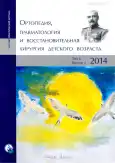ОПТИМИЗАЦИЯ РЕЗУЛЬТАТОВ И СРОКОВ ЛЕЧЕНИЯ ГЛУБОКИХ ДЕРМАЛЬНЫХ ОЖОГОВ У ДЕТЕЙ
- Авторы: Афоничев К.А.1, Филиппова О.В.1, Цветаев Е.В.2
-
Учреждения:
- ФГБУ «НИДОИ им. Г. И. Турнера» Минздрава России
- СПб ГБУЗ «Детская городская больница № 1»
- Выпуск: Том 2, № 2 (2014)
- Страницы: 9-11
- Раздел: Статьи
- Статья получена: 15.01.2015
- Статья опубликована: 15.06.2014
- URL: https://journals.eco-vector.com/turner/article/view/245
- DOI: https://doi.org/10.17816/PTORS229-11
- ID: 245
Цитировать
Полный текст
Аннотация
Глубокие дермальные ожоги у детей, заживающие самостоятельно, являются причиной длительного лечения и выраженных рубцовых деформаций, что приводит к плохим косметическим результатам и в значительной степени ухудшает функциональный результат. Проблема оптимизации результатов и сроков лечения глубоких ожогов у детей в последние годы стала особо актуальной. Под нашим наблюдением находилось 1853 ребенка с ожогами III-A степени. У части детей ожоги зажили самостоятельно, что привело к развитию рубцовых деформаций уже в первые полгода после травмы. Выделены факторы риска их развития в зависимости от возраста больного и локализации поражения. Другим детям было выполнено ранее тангенциальное иссечение струпа. Анализ результатов лечения показал, что применение раннего оперативного пособия у детей с глубокими дермальными ожогами позволяет сократить сроки лечения, а также существенно улучшить косметические и функциональные исходы травмы.
Ключевые слова
Об авторах
Константин Александрович Афоничев
ФГБУ «НИДОИ им. Г. И. Турнера» Минздрава России
Email: afonichev@list.ru
д. м. н., руководитель отделения последствий травмы и ревматоидного артрита
Ольга Васильевна Филиппова
ФГБУ «НИДОИ им. Г. И. Турнера» Минздрава России
Email: olgafil-@mail.ru
к. м. н., старший научный сотрудник отделения последствий травмы и ревматоидного артрита
Евгений Викторович Цветаев
СПб ГБУЗ «Детская городская больница № 1»к. м. н., врач травматолог-ортопед ожогового отделения
Список литературы
- Будкевич Л. И. Летальность как основной показатель эффективности лечения детей с термической травмой / Л. И. Будкевич, С. И. Воздвиженский, В. М. Розинов и др. // Проблемы термической травмы у детей и подростков: Матер. Межрег. науч.-практ. конф., посвящ. 10-летию Ожогового центра 9-й Детской гор. клинической б-цы. Екатеринбург, 2003. С. 8-9.
- Кислицин П. В. Хирургическое лечение пограничных ожогов у детей / П. В. Кислицин, А. В. Аминев // Сб. науч. тр. I Съезда комбустиологов России. М., 2005. С. 888-999.
- Коваленко О. Н. Особенности хирургического лечения детей с термической травмой / О. Н. Коваленко, А. А. Жернов, Г. П. Козинец, Л. С. Сочиенкова // Проблемы термической травмы у детей и подростков: Матер. Межрег. науч.-практ. конф., посвящ. 10-летию Ожогового центра 9-й Детской гор. клинической б-цы. Екатеринбург, 2003. С. 94-95.
- Таран В. М. Хирургическое лечение ожогов III-А степени / В. М. Таран, В. В. Бигуняк // Комбустиология на рубеже веков: Матер. Междунар. конгр. М., 2000. С. 888.
- Цветаев Е. В. Инфракрасное зондирование тканей - метод объективной оценки глубины ожога / Е. В. Цветаев, А. Н. Новиков, А. Г. Баиндурашвили // Актуальные проблемы травматологии и ортопедии: Матер. науч. конф.: Ч. II. Термическая травма. Н. Новгород, 2001. С. 125-126.
- Jancekovic Z. A new concert in the early excision and immediate grafting of burns / Z. Jancekovic // J. Trauma. 1970. Vol. 10, № 12. P. 1103-1108.
Дополнительные файлы








